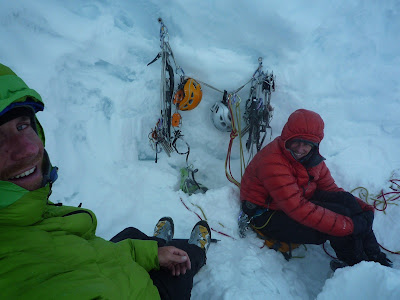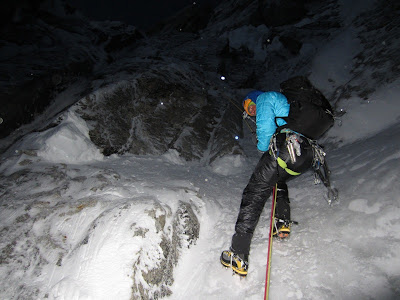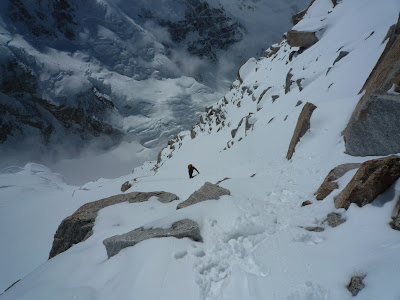We flew into Kahiltna Basecamp on May 12. We wanted to do some easy peak bagging first thing, as a warm-up and to acclimatize a bit. On May 13 we went for our first romp, up Radio Tower, which is a small bump just above basecamp. Nils near the top of Radio Tower:

The next day, May 14, we climbed the "Mini Moonflower" by its trade route, the North Couloir:

Nils crossing the 'schrund on Mini Moonflower:

Nils climbing the crux pitch on Mini Moonflower's North Couloir. The route is a moderate alpine-ice gully, very reminiscent of the popular ice gullies on the east face of Mont Blanc du Tacul.

Colin high in the North Couloir of Mini Moonflower:

Nils nearing the summit of Mini Moonflower:

The following day, May 15, we climbed the East Ridge of Mt. Francis:

Nils high on the East Ridge of Mt. Francis. There were many thinly-bridged crevasses, and I took my first-ever full-body crevasse fall (as opposed to punching a leg through, which I have done many times) - fortunately we were roped up!

After a rest day, we climbed Peak 12,200 on May 17 via its southwest ridge:

Colin on the southwest ridge of Peak 12,200:

On the summit of Peak 12,200 in a whiteout:

Colin on the descent of Peak 12,200:

The next day, May 18, we climbed Humble Peak (often erroneously referred to as "Kahiltna Queen") by the standard route on its west face:

Nils in the big couloir on the west face of Humble Peak:

Nils on the upper ridge of Humble Peak:

Nils just below the summit of Humble Peak:

Colin demonstrating a skier's approach to bergschrund crossings, on the descent of Humble Peak:

Feeling sufficiently acclimatized, and after a few days of bad weather, we made an attempt on one of our main objectives: the north buttress of Begguya (also referred to as "Mt. Hunter"). It is fortunate that climbers have finally largely abandoned the name "Mt. McKinley" in favor of "Denali" for North America's highest mountain - it is high time we also start using the terms "Begguya" and "Sultana" rather than "Mt. Hunter" and "Mt. Foraker." Not only is it ridiculous for western explorers to rename mountains which had been named thousands of years earlier by the native Americans who lived within sight of them, but many of the western names have almost no connection to the area in which the mountain is located. The name "Mt. Hunter" comes from Anna Falconett Hunter, who was the aunt of Robert Dunn, who was a newspaper reporter from New York on Frederick Cook's [who later was found to lie about an ascent of Denali] 1903 Denali expedition. Not only does the name "Hunter" have almost no connection to the mountain, but it was originally applied to Kahiltna Dome and later accidently applied to Begguya!
Likewise, it is time we start referring to "Mt. Rainier" as "Tahoma," "Mt. Baker" as "Kulshan" and "Glacier Peak" as "Dakobed," among others...
On May 23 we attempted the north buttress of Begguya via a combination of the "Deprivation" route and the Bibler-Klewin route:

Colin just above the bergshcrund on Deprivation:

Nils a couple rope-lengths above the 'schrund on Deprivation. Conditions on the lower part of the route seemed quite good, and we were able to simul-solo to the base of the route's crux pitch.

Colin climbing a steep ice step shortly before the crux pitch of Deprivation:

Nils soloing more moderate alpine ice:

Colin starting up the crux pitch of Deprivation. I thought the technical difficulties on this pitch were not extreme (AI5), but it was definitely X-rated, with about a 20 meter runout through the steepest portion, on vertical neve.

Colin starting the ramp above the first iceband on Deprivation:

Nils arriving at the left-trending ramp above the second iceband on Deprivation:

In the third iceband we diverged from the original Deprivation route, and joined up with the Bibler-Klewin route. Nils starting the "Bibler Come Again" exit pitches:

Nils starting up the final iceband above the Bibler Come Again exit:

The weather started to deteriorate quickly as we were climbing the final iceband, and by the time we had passed the "cornice bivy" it was windy and snowing hard. Nonetheless, we were hopeful that it was just temporary, and continued up the ridge until we could find a crevasse to take shelter in. Inside the crevasse we had some shelter from the wind and snow, and spent a couple hours eating and re-hydrating. We had taken 9 hours to climb from the bergschrund on Deprivation to the crest of the north buttress, which we were quite pleased with.

After we finished brewing we packed up to head towards the summit, but upon exiting the crevasse we found the weather had gotten much worse, and was now snowing very hard and very windy. Disappointed, we returned to the crevasse to reorganize, and starting descending, approximately 600 vertical meters shy of the summit. Colin rappelling the final iceband:

For the first half of the descent the weather was very bad, and we were hit almost constantly by big spindrift avalanches. Nils starting another rap on the final iceband:

We chose to rappel the Bibler-Klewin route rather than Deprivation, because Deprivation is a very traversing route. Colin rapping below the "Vision" pitches:

Yet more rappelling... The nice thing about rappelling the North Buttress is that there is enough ice to rappel on v-threads the entire way, and by threading the rope directly through the v-threads we were able to rappel a 1,500m buttress without leaving behind a single sling!

A view of Begguya from Humble Peak. This view offers a good perspective, and shows clearly that the top of the north buttress is only about two-thirds of the way up the route.

Back in basecamp the day after our attempt on Begguya. Our weather-thwarted attempt was surrounded on either side by perfectly sunny days. Unfortunately, with next-to-useless weather forecasts available for the Central Alaska Range, we had no way to predict which days would be better or worse, since the forecast for every single day is "partly cloudy, chance of showers." On the left is Nils, and on the right is Swedish extreme skier Andreas Fransson, who had just returned to basecamp after making the first ski descent of the south face of Denali (roughly following the Haston-Scott route), which was the most significant accomplishment of 2011 in the Central Alaska Range.

Other notable activity on the north buttress of Begguya this season included two attempts by British parties and an ascent by a Korean team:
-English alpinists Jon Bracey and Matt Helliker attempted a new variation of the Bibler-Klewin route. They climbed in heavy, slow style (with a portaledge and plenty of food), but nonetheless in clean, alpine style. Starting just to the left of the Bibler-Klewin and right of Wall of Shadows, they climbed difficult new terrain until joining the Bibler-Klewin route on the second iceband (approximately half-way up the buttress and one-third of the way up the Bibler-Klewin route). They followed the Bibler-Klewin route to the top of the buttress, and retreated approximately 600 vertical meters shy of the summit.
-Scottish alpinists John "Spider" McKenzie and Paul "Stork" Thorburn attempted the Bibler-Klewin route, climbing to the top of the buttress and retreating approximately 600 vertical meters shy of the summit.
-Like the 2010 season (when two young French climbers made an ascent of the Bibler-Klewin route), there was only one ascent of Begguya by the north buttress in 2011. A strong Korean team composed of Sukmun Choi, Jongil Park and Heeyong Park made the solitary ascent of the season, via the Bibler-Klewin route.
After our attempt on Begguya we packed up basecamp and headed up to the 14 camp on Denali. We were greated by exciting news that four of our good friends from Chamonix had just made fast climbs of the Cassin Ridge. Swedes Andreas Fransson and Magnus Kastengren climbed the Cassin with one bivouac round-trip from the 14 camp. This is a notably fast time, especially considering that Andreas had very little rest after his descent of the south face, and also because both of them are more skiers than they are climbers. British climbers Jon Griffith and Will Sim had just climbed the Cassin as a day-trip, going from the bergshrund to the summit ridge in 14:40. Jon and Will did not finish the route to the summit of Denali, and thus it cannot truly be considered a speed record (it would be exactly analogous to Ueli Steck stopping his watch upon reaching the Mittellegi Ridge rather than on the summit of the Eiger). Ironically, however, Mugs Stump did not reach the summit of Denali either during his famous climb of the Cassin Ridge in 1991. Mugs climbed from the bergschrund to the summit ridge in 15:00, so in any event Jon and Will made a very impressively fast climb and an improvement upon Stump's time.
Considering how easy the final summit ridge of Denali is from where the Cassin joins it, it might seem difficult to understand why anyone would retreat from there. However, from personal experience I know that climbing the Cassin Ridge as a day trip is extremely exhausting physically, and when you are suddenly presented with an option to go down a beaten track it takes a lot of motivation to instead continue walking uphill. Add into the mix the fact that Jon and Will reached the summit ridge in cold, windy weather, and it becomes easier to understand their decision.
Chamonix crew at the 14 camp on Denali - from left to right: Jon Griffith, Will Sim, Nils Nielsen, Andreas Fransson, Colin Haley and Magnus Kastengren. Jon and Will have been the most active alpinists of the past couple years in the Chamonix valley, Andreas has been the most active extreme skier of the past couple years in the Chamonix valley, and Magnus is an evil genius.

During his last trip to the US (to Yosemite Valley), Magnus ran into trouble with the law, so this time he was doing his best to fit in as an average American:

Nils and I spent a couple weeks acclimatizing at the 14 camp on Denali. On June 4 we climbed and skied the "Rescue Gully," which is a broad gully below the 17,000 ft. camp. Colin on the way up the Rescue Gully:

Nils skiing the upper portion of the Rescue Gully:

Colin skiing lower down in the Rescue Gully. There hadn't yet been much snow at this point, and it took careful route-finding to avoid patches of blue ice.

On June 6 we went to the summit of Denali for Nils's first time and my eleventh time, via the Upper West Rib. Nils near the top of the Upper West Rib:

On the summit of Denali:

Colin on the descent of the West Buttress with an altitude headache:

Colin skiing powder above the 14 camp on a rest day:

A guided group gave us a couple climbing magazines to read. Colin learning to train like Ueli, but wondering, "What the fuck is mental training???"

On June 10 we went to the summit of Denali a second time, via the Orient Express. Colin climbing up the Orient Express:

Nils on Denali's final summit ridge:

On the summit of Denali again - this time fortunately with skis:

Nils making the first couple turns below the summit of Denali. Surprisingly, the snow here was the best of the whole descent, with creamy, dense powder.

Colin starting down the upper part of the Orient Express:

Colin skiing the Orient Express:

Nils skiing the Orient Express:

After sufficient acclimatization we felt ready to try another of our main objectives: the Cassin Ridge. Unfortunately, like I experienced in 2010 with Bjørn-Eivind Årtun, once we were well acclimatized it began to snow a lot. There were other teams at the 14 camp intending to climb the Cassin, but unfortunately, when the weather broke no one seemed interested in starting up the route unless somebody else put a track in. Thus, running out of time, we left the 14 camp on the evening of June 17, pessimistic about the snow conditions but eager to try nonetheless. Taking off from 14 camp:

Like in 2010, we approached via the Seattle '72 Ramp, and it worked excellently. Without tracks to follow, and going at a moderate pace to conserve our energy, we still arrived at the bergschrund below the Japanese Couloir only 3 hours after leaving the 14 camp. Colin at the brew stop below the Japanese Couloir:

After having some dinner and re-hydrating, we crossed the 'schrund and started up the route. Colin in the Japanese Couloir:

Nils at the top of the Japanese Couloir:

Colin on the crux of the Cassin Ridge, above Cassin Ledge:

Nils on the crux:

The Japanese Couloir was in excellent condition, with either neve or soft ice the whole way. Unfortunately, after there our fears were confirmed, with lots of fresh snow on the route. Nils on the knife-edge ridge:

Nils near the top of the Hanging Glacier, with deep trail-breaking:

Nils climbing in the First Rock Band:

Nils higher in the First Rock Band:

Colin wallowing through deep snow in the First Rock Band:

Nils on an awkward move in the First Rock Band:

Colin wallowing through more deep snow in the First Rock Band:

Nils wallowing between the First Rock Band and Second Rock Band:

Nils wallowing in the Second Rock Band:

Slightly steeper wallowing in the Second Rock Band:

Nils wallowing in the Second Rock Band:

Nils wallowing in the Second Rock Band. Just above this point, we had a very scary experience. Nils was climbing in front, and accidentally released a small slab avalanche directly above me. Although it was a small area, the slab was thick and dense and nearly swept me off. Needless to say, I was quite shaken up and not very psyched when we arrived at a brew stop on top of the Second Rock Band just above. We had made good time up to this point, taking 6 hours from the bergschrund to the top of the Second Rock Band, but because of all the deep snow we had used up way more energy than we would have liked.

Nils breaking trail above the Second Rock Band. Normally here you walk out in the middle of the snow slopes, but we hugged the rocks to mitigate the scary avalanche conditions.

Nils wallowing above the Second Rock Band:

After rejoining the ridgecrest above the Third Rock Band, at approximately 18,000 ft, we stopped to take a break. So much trail-breaking through the deep snow had completely exhausted us, and we decided we were too tired to safely continue upwards. We bailed via a long descending traverse across the upper southwest face to the Upper West Rib and eventually back down to the 14 camp. Nils on the traverse across the upper southwest face:

Nils near the end of the long traverse:

After our attempt of the Cassin we were nearly out of time on our expedition, so we packed up camp at 14, and headed down to basecamp. Colin waiting for the weather to clear and TAT to pick us up:



